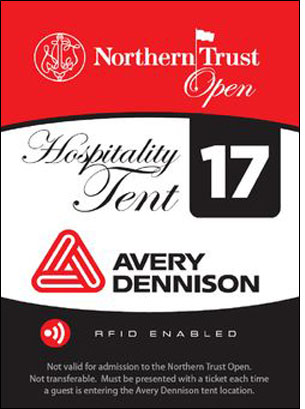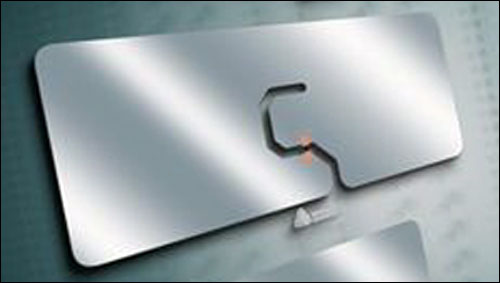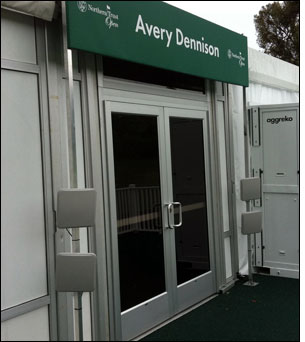Last September, at the Tour Championship, the final event of the PGA Tour playoffs, at Atlanta’s East Lake Gulf Club, the PGA Tour, the organization that runs the majority of events comprising the tournament series that bears its name, launched a pilot to test the use of radio frequency identification. The technology is currently making a second stop, at the PGA Tour’s Northern Trust Open at the Riviera Country Club, in Pacific Palisades, Calif.—where RFID tag manufacturer Avery Dennison is issuing RFID-enabled badges to guests of its private hospitality tent. The pilot program’s goal is to ascertain how RFID might provide PGA Tour and its corporate sponsors with increased visibility into the management of its specialty hospitality services.
At last year’s Northern Trust Open, representatives from Avery Dennison approached the golfing organization and suggested that it could benefit from employing RFID to help it automate a number of processes at its events, says Jack Tyson, PGA Tour’s director of ticketing operations. The company suggested that Stark RFID, an RFID tag converter and a provider of RFID software customized for event management, would be a great partner to test the technology as well. Soon thereafter, Tyson says, Lance Burnett, Stark RFID’s CEO, traveled to the Players Championship, a PGA Tour event held in Ponte Vedra Beach, Fla., to observe the outing and suggest where RFID might be of most use.

The verdict: RFID could help PGA Tour and its corporate sponsors keep tabs on attendance to the various corporate-sponsored hospitality tents at its golf events. There are three types of hospitality tents at events, Tyson explains: private, reserved and shared. Single corporate sponsors pay for, and have access to, private tents, whereas reserved tents are the domain of a few different sponsors, and shared tents are paid for and utilized by a larger number of sponsors. At all three types of tents, guests are generally issued wristbands, color-coded to signify the tent to which they have access, as they initially enter a tent and check in with a host, who confirms their names are on the guest list. After that, they are free to exit and reenter that particular tent throughout the event.
This system works, Tyson says, but it does not provide PGA Tour with any visibility into the flow of guests into and out of the tents throughout an event. So for the first phase of the pilot project, conducted at last year’s Tour Championship, Stark RFID created wristbands with embedded Avery Dennison AD-843 EPC Gen 2 tags, and one hospitality tent was selected as a test area. Each guest entering that tent was issued an RFID wristband encoded with a unique ID number upon check-in. As that individual entered and exited the tent, he or she would walk through a read zone that Stark RFID set up using an Alien Technology ALR-9900 reader with antennas from Motorola Solutions. (The tent had two entry/exit points, and thus two read zones.)
After the event, Burnett says, the number of unique IDs collected at the read points was found to match the quantity of guests who’d checked into that tent, indicating a 100 percent read rate. The water within a human body can absorb radio signals, which sometimes interfere with passive tag reads, but the large antenna used in the AD-843 helps ensure readability by capturing more of the reader’s signal.
“I was actually a little surprised to see 100 percent,” Burnett says, “because the tags were embedded in wristbands, which are worn close to the body, rather than on a lanyard around the neck, which gives more air buffer. But the AD-843 is a great performer—we call it the Silver Bullet.”
PGA Tour was pleased with the technology’s results at the Tour Championship, Burnett says, especially compared with a parallel test it conducted in a neighboring tent at the same event, during which bar-coded tickets were issued to guests. Because the guests needed to present their tickets for scanning every time they entered and exited the tent, queues eventually formed. Those issued bar-coded tickets were dissatisfied, he notes, and some dubbed the tent “Checkpoint Charlie.”
“The difference [between the two systems] was off the charts,” Tyson states. “So from a contrast perspective, we knew RFID is a much better solution to having a good flow of traffic. In a head-to-head competition, RFID performed better than bar code for hospitality tents.”
While the pilot did not extend beyond data collection, Tyson has identified other ways in which improved visibility of traffic flow could benefit PGA Tour. One area, he says, is in food and beverage service. At present, catering vendors charge PGA Tour based on the number of people that it estimates were served. But an actual headcount of guests entering the hospitality tent, he says, including the exact number of times that each person comes in and goes out, could provide Tyson with a way to audit the figures on which the vendors base their charges.
For this week’s Northern Trust Open event, Avery Dennison worked with Stark RFID to embed the AD-843 tag into a badge issued to guests checking in at Avery Dennison’s private hospitality tent. Around the tent’s single entry and exit point, an Alien ALR-9900 reader with Motorola antennas has been set up, controlled by software from Stark RFID. Unlike the RFID wristbands utilized at the Tour Championship, which were issued to guests but not linked to their identities, each badge provided to one of Avery Dennison’s visitors is paired with that person’s name. When a guest, wearing the badge on a lanyard hung around the neck, enters this tent, the reader collects the ID number encoded to the badge’s RFID tag and transmits that information to the software, which matches that ID with the guest’s name. A message then appears on a large monitor inside the tent, such as “Welcome, Mr. Smith.” If that guest leaves and then reenters, the message “Welcome back, Mr. Smith” is displayed.
In addition, Stark RFID has created an iPad application that allows the host of the Avery Dennison tent to see who is inside the tent at any given time. The name of each guest appears, along with his or her affiliation. “We could also include a photo of the person, if we have one,” Burnett says, “or the end user could even upload the photos themselves, beforehand.”
During this weekend’s event, the host will use this application to facilitate introductions between key guests and Avery Dennison’s representatives.

After the Northern Trust Open winds up on Sunday, Tyson says, PGA Tour may continue testing the system at this year’s Players Championship tournament, though that has yet to be confirmed. “From our perspective, the cost versus benefit is still to be determined,” he notes. “But if, for example, we find that we are paying more than we need to for food and beverage service, that’s a cost savings.”
According to Tyson, if an RFID solution were adopted for all of the series’ events, PGA Tour might include that system as an add-on service to the various hospitality service packages it currently offers its corporate sponsors.
Other organizations have deployed RFID at golf courses over the past several years. In 2009, ID badges containing high-frequency (HF) 13.56 MHz passive tags were issued to 3,000 guests, staff members and other individuals at an event in France (see Golf Tournament Tees Up RFID). And in 2006, England’s Wentworth golf course deployed an active RFID system to track how many of its members use its three 18-hole courses (see At Wentworth Club, RFID Tags Are Members-Only).


